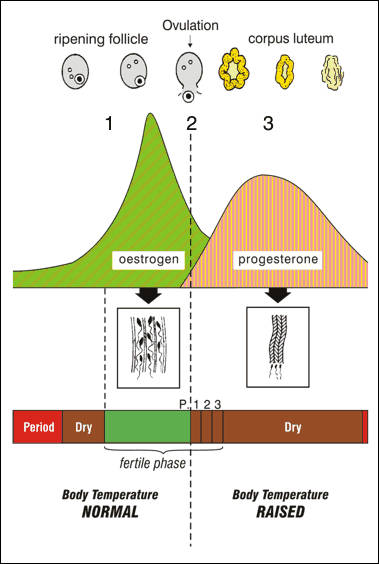How Fertility Awareness Methods work
A woman is only fertile for up to 1 week each menstrual cycle (5 days before ovulation and 24 hours after ovulation).
A man is fertile all the time.
A woman’s body shows various signs (biomarkers) that allow her fertility to be tracked (charted). She can know when she is at a fertile time and when she is at an infertile time of her cycle. With this knowledge, a couple can time intercourse according to whether they want to achieve or avoid pregnancy.
There are many different FAMs and each one uses one or more of the biomarkers described below. There will be circumstances where a woman finds it difficult to chart one of these markers. The good news is that there will be another biomarker that is suitable for her.

© 2011 Fertility Education & Training http://www.fertilityet.org.uk/ used with kind permission from Mrs Colleen Norman.
Here are some of the biomarkers used to chart fertility:
- Cervical mucus- there is a special type of fertile mucus produced by the cervix in the days leading up to ovulation. This mucus is wet and slippery. Sperm can survive in this fertile mucus for up to 5 days. For the rest of the cycle, a mesh-like mucus plug forms in the cervix and sperm are unable to survive or enter the uterus.
- Temperature- after ovulation, a woman’s basal body temperature rises by 0.2 degrees. Taking a daily morning temperature and plotting it on a chart will show an upward temperature shift after ovulation. Temperature can be affected by lifestyle factors such as stress, shift work, travel and alcohol.
- Urinary hormone measurements:
- There is a rise in oestrogen as a follicle develops, leading up to ovulation
- An LH surge triggers ovulation
- Progesterone rises after ovulation
- Cervix – the cervix becomes soft and open around the time of ovulation. At infertile times of the cycle, the cervix is hard and closed.
- Cycle length- a woman’s cycle length will vary from woman to woman and depending on her circumstances. Looking back over the length of a woman’s shortest and longest cycles for the past 6-12 months and applying a calendar calculation gives a rough estimation of the earliest and latest days of fertility for that woman’s cycle.
